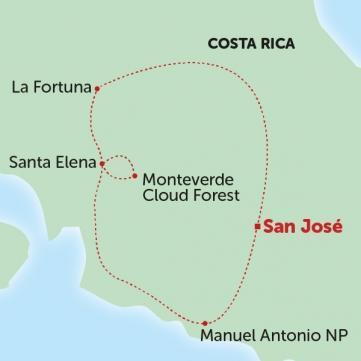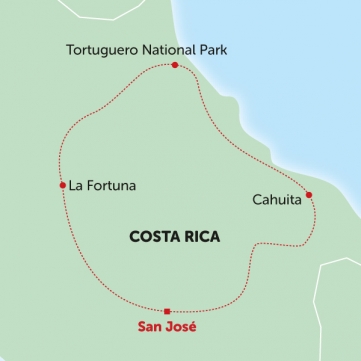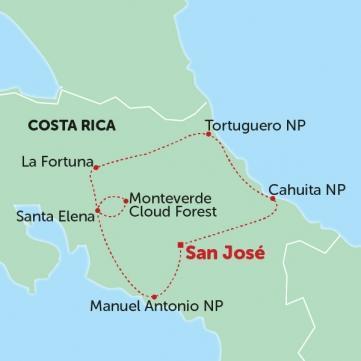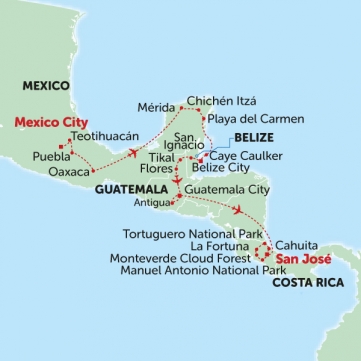Book NOW for $1 £1 €1 • Flexible Payments • No Change Fees • Private Departures Available
- Home >>
- Costa Rica Travel Advice
Costa Rica Travel Advice
Getting to
Costa Rica
Costa Rica is situated in Central America, lying between the Caribbean Sea and the South Pacific Ocean. If you are up for a patient, (and very long!) adventure, it is possible to drive to Costa Rica from North America and South America. Here are a few estimates for how long it could take to get to Costa Rica with a direct flight:
- London to Costa Rica is about an 11 hour flight
- Los Angeles to Costa Rica takes around 7 hours
- Cape Town to Costa Rica takes around 30 hours
- Sydney to Costa Rica is about a 23 hour flight
- New York to Costa Rica can take around 7 - 8 hours
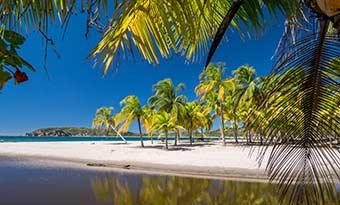

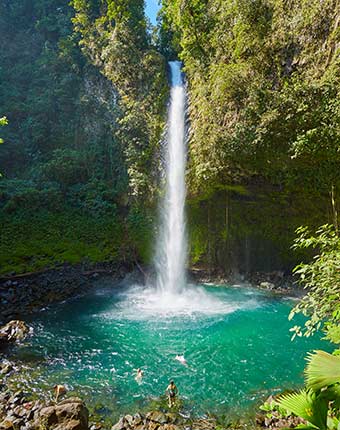
Main airport for
Costa Rica
Costa Rica has two international airports. San Jose (SJO) airport is in Alajuela, which is within the Central Valley region. The Liberia (LIR) airport, is located in Liberia. Costa Rica also has multiple smaller airports which serve domestic flights but which mostly only depart from San Jose.
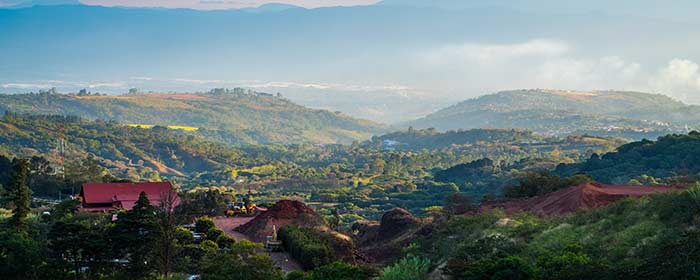
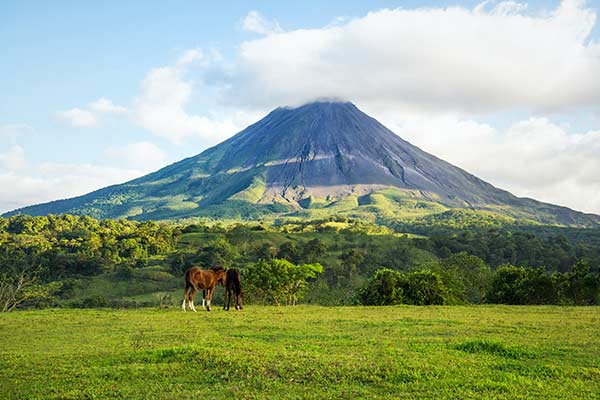
Geography and landscape
of Costa Rica
Costa Rica’s landscape is diverse to say the least! Towering mountains, active and dormant volcanoes, cascading waterfalls, powerful rivers, rainforests, cloud forests, mangrove forests, white and black sand beaches and coral reefs and all make up this incredible landscape that is about 9 times smaller than the UK! It lies between both the Caribbean Sea and the South Pacific Ocean, neighbouring Nicaragua and Panama. The coastal plains are low, with Cerro Chirripo being the highest peak, standing at 3819 meters.
Culture, religion
and etiquette
The state religion of Costa Rica is Roman Catholic where beliefs and traditions are prevalent in all walks of life, festivals, celebrations and holidays. 76.3% of citizens identify as Roman Catholic, 13.7% are Evangelical Christians, 1.3% identify as Jehovah’s Witness with 0.7% being Protestant Christians. Costa Rica has a population of 5 million people which the majority having European descendants due to being a Spanish colony for a long time. Around 100,000 people are Native American or indigenous inhabitants, who live in the more secluded areas of the country.
Ticos (Costa Ricans) have a friendly, relaxed and easy going culture, however are often quite formal in conversation. If there is one term you learn for Costa Rica make it “pura vida”. The literal meaning is ‘pure life’ but it is also much more than that - it’s a way of life! Often used as hello, a greeting, how are you, everything is great, and often just said as a statement. Another commonly used reference is ‘tico time’. Costa Ricans are very relaxed when it comes to punctuality, often being 15 minutes to an hour late - this is ‘tico time!’
Due to being a proud neutral country, Ticos are not fans of confrontation. Avoid criticising a Costa Rican unless you know them really well. Clothing wise, men dress conservatively whereas women tend to show a little more skin.You will however be very obvious as a tourist if wearing shorts or sandals in the towns. Men and women often greet each other with a light kiss on the cheek and men meeting men shake hands.
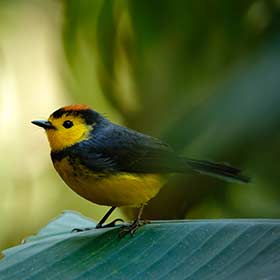
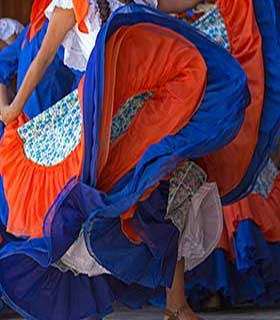
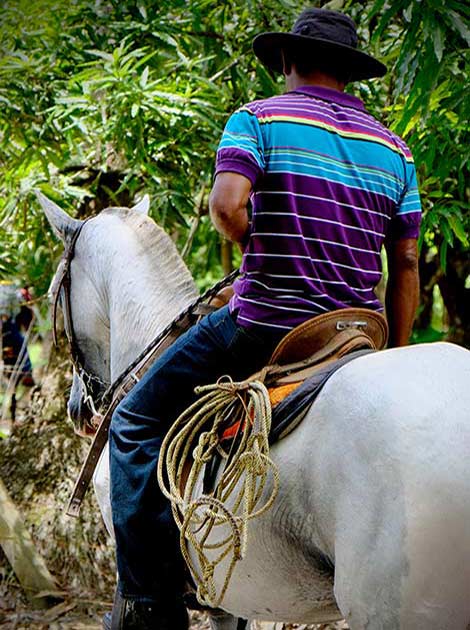
Did you know?
Directions and addresses are usually given in distances from the nearest landmark, not the street name! E.g The address for the Costa Rican Vacations office is 100m west and 50m north of the National Stadium.
Photography
Costa Rica is the wildlife photographers dream! With plenty of national parks, jungles, waterfalls, volcanoes, cloud forests, rainforests and beaches all teeming with magical flora and fauna, it’s a hard task to actually have time away from the lens! Due to the majority of the Costa Rican landscape comprising of jungle, rain can happen at almost any given moment, so make sure you bring a camera bag to cover your gear! If you are serious about photography, consider bringing a tripod, a big lense (e.g 600 mm with 1.7x teleconverter) and a macro lense (105, 120 or 180 mm). With so many subjects to capture from tiny, 2 inch red-eyed tree frogs to sturdy 700 pound tapiers, you'll be glad to have the range!
Languages spoken
Spanish is the national language of Costa Rica, but English is widely spoken throughout the country. However, it always bodes well to learn at least a few key phrases in the national language, it can go a long way with the Costa Ricans! There are also a selection of indigenous languages spoken such as Cabécar, Bribri, Boruca, Chibchan, and Maléku. The Caribbean coast of Costa Rica is the only area where Spanish is not the main language - here it is English. People in this area also speak Patua, a dialect which is a combination of English, Spanish and French.
Capital city
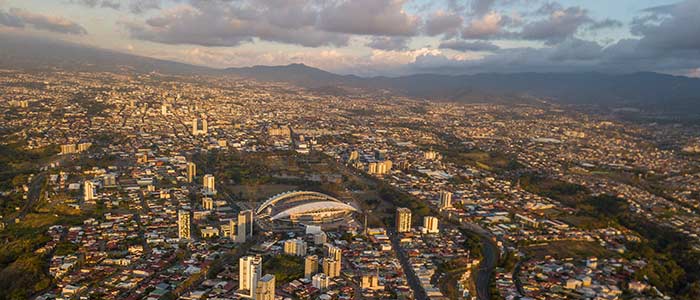
San José
The capital city of Costa Rica is San José, where one of the two international airports are located. The city lies in Costa Rica’s western province in the central valley, has a population of 339,581 (2017) and covers a total of 44.2 square km. San José is Costa Rica's largest city. Being the cultural hub of the country, the city boasts a wide selection of museums, galleries, parks, restaurants and a great nightlife!
Visas
Most nationalities don’t require a visa when visiting Costa Rica, Including UK and US nationals. However, your passport needs to be valid for a minimum of one day from the day you enter Costa Rica. The maximum stay is 90 days - if you intend to stay for longer, you will need to obtain a residence permit. If you are in the group of nationalities which do require a visa, this must be applied for within at least 90 days before you are due to travel.
Vaccinations & travel health
Vaccines
Travel advice for vaccines may vary slightly depending on your country of origin. But for the majority, the CDC and the WHO advise that you will need to be up to date on all routine vaccinations. These include: MMR (Measles, Mumps, Rubella), TDAP (Tetanus, Diphtheria & Pertussis), Chickenpox, Shingles, Pneumonia, Influenza, Meningitis and Polio.
The following vaccines are also recommended for travel to Costa Rica: Hepatitis A, Hepatitis B, Typhoid, Yellow Fever (if travelling from a country with risk of yellow fever transmission) and Rabies (recommended for long-term travellers and those who may come into contact with animals).
Mosquitos & Malaria
The risk of Malaria in Costa Rica is low, however as you cannot be vaccinated against it, it is highly recommended that you use a mosquito net and repellent during your stay. The risk of Malaria in Costa Rica is not high enough to advise tourists to take a course of anti-Malaria tablets.
Is it safe to drink tap water in Costa Rica?
It is generally safe to drink tap water in Costa Rica, aside from the more rural, underdeveloped parts of the country. If you want to be extra cautious, you can either drink bottled water, boil your water before drinking, or use iodine pills to purify the water.
Electricity and plugs in Costa Rica
Costa Rica uses the same voltage and plugs as in the United States, which is 110 - 120 volts, 60 Hz. The plugs are usually those with 2 flat prongs. US citizens will not normally need a converter or adapter, whereas the UK and Europe will. If you forget to bring a converter, hotels will often have one you can borrow. Failing that, they can easily be purchased in San José.
Emergency calls
It’s always a good idea to have a few numbers saved on your phone or written down in case of an emergency. The most important ones to note in Costa Rica are:
- 911 Emergency services
- 128 Ambulance
- 118 Fire services
- 117 Police
- 116 International collect calls
- 506-8863-4895 US embassy services
Travelling as a single woman
Solo women travelling in Costa Rica is pretty common with most tourists leaving the country with only fond memories. You’ll be happy to know that it is often voted as one of the safest places in the world.
Regarding dress, Costa Ricans are pretty casual, but if you show a lot of skin outside of the beach, expect to get a few calls thrown your way. As Costa Ricans in general are very non-confrontational, a simple no will usually suffice if you get too much unwanted attention.
Machismo is the only thing which really calls to be said about feeling safe in Costa Rica as a solo woman. Male chauvinism is very much still alive over here and whilst it can feel very forward and over-assertive having men wolf-whistle and shout ‘mi reina’ (my queen) or ‘que linda’ (how pretty) after you, it usually doesn’t go any further than that. Simply walk past and ignore them. You are normally not in any danger, it's just a fairly common, but persistent annoyance.
Tip!
Buy a Costa Rican SIM card. They are very cheap, easy to set up and with available wifi in all the main tourist spots as well as restaurants and hotels, it's much better than facing astronomical roaming charges! Kolbi is the largest mobile network in Costa Rica and you can buy SIM cards from most supermarkets and convenience stores.
The majority of Costa Rica as an area is pretty safe, however use your common sense. Don’t walk around San Jose at night alone (like you wouldn’t in any other city), keep your family informed on your whereabouts and don’t leave your belongings unattended or flash your cash in the streets. Costa Rica does have an unusually high crime rate, however this is mostly drug related and does not involve tourists. In high tourists areas such as Manuel Antonio, there are often hoards of touts attempting to 'sell' tours which inevitably don't exist. If it sounds too cheap, it probably is and if the tour is real, they will most likely take you back to the office to confirm.
Wifi and internet access
Wifi is readily available in most of Costa Rica, with many public places such as airports, restaurants, railway stations and public parks providing wifi hotspots to connect to. Most hotels also provide free wifi but depending on the location, it could be restricted to the lobby. If travelling into the more remote areas of Costa Rica don’t rely on getting wifi access. It is often spotty or inexistent.
Time zone
San José, Costa Rica
Costa Rica (CST) is 6 hours behind of London (GMT/UTC), 2 hours ahead of Los Angeles and 1 hour behind New York. Costa Rica does not have a daylight savings time clock change. To calculate the time difference from your current location, visit timeanddate.com.
Getting around
Being a relatively small country, Costa Rica is fairly easy to get around - you could easily drive the length or width of the country in one (albeit long) day! And due to the fair amount of tourism the country sees each year, they have a variety of travel options to choose from depending on your needs and itinerary.
Bus
The bus service in Costa Rica is the most popular way to get around. Buses are usually at a decent standard, although most don’t provide air conditioning. They are relatively cheap (around $3 from town to town), and run frequently, although usually not to schedule. San Jose is where all buses depart from, so chances are, you will need to head back there to go onto somewhere else. It is advised to pre-book tickets if you are travelling a popular route, however you can only book single tickets, so book the return journey as you arrive at your destination.
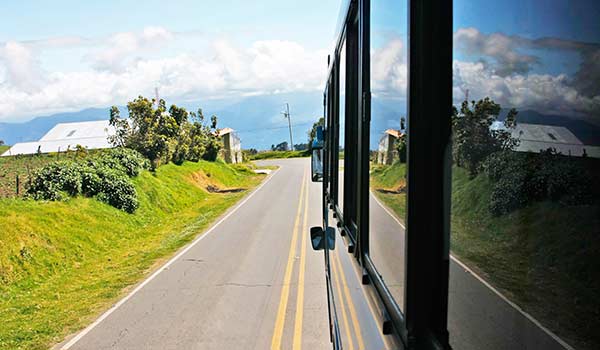
Air
Domestic flights across the country are relatively cheap and a great time saver if you have a busy schedule. Costa Rica have two domestic air carriers - Sansa and NatureAir, which fly all over the country including popular beach destinations and provincial towns.
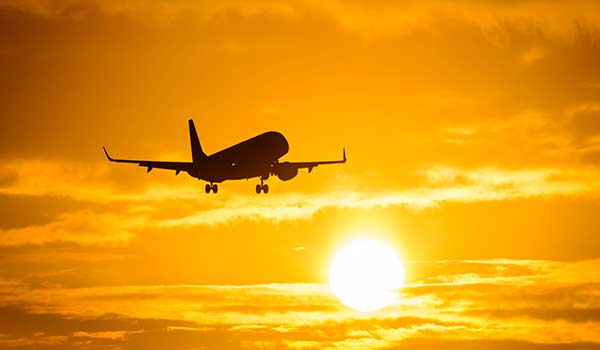
Taxis
If you want to use a taxi, stick to the red ones with yellow lights on the roof. These are the official taxis of Costa Rica. All other taxis are illegal and will pretty much charge you whatever they want! Red taxis will have a meter so there shouldn’t be any chance of you being ripped off. In urban areas, taxis are around ₡630 ($1.17) for the first km and ₡610 ($1.13) for each additional km. In rural areas, taxis are around ₡770 ($1.43) per km. San Jose also has the option of Uber.
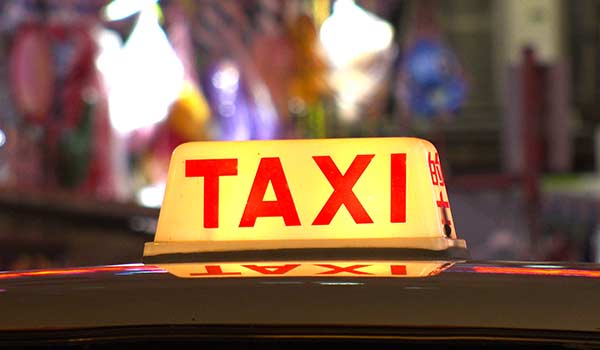
Private car hire
Private car hire is fairly common in Costa Rica, however it is only recommended if you are a confident driver. The roads in the highlands can be a little scary when driving around blind bends with sheer drops, and potholes are almost everywhere. You will also get the frequent cow crossing in front of you. That said, it is a great way to travel if you are on your own time and visiting remote areas.
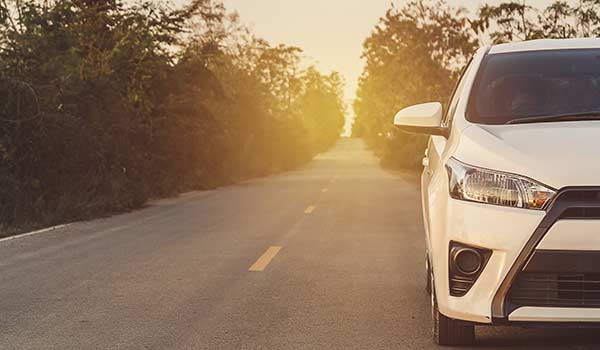
History
The first European person to tread the soil of this exotic land was none other than the great explorer himself, Christopher Columbus. He reached Costa Rica in September 1502. A group of Carib Indians came to greet him at the shore brandishing golden bands worn through their noses and ears - which is what inspired the naming of Costa Rica, meaning ‘rich coast’. Archaeologists now know that civilisation began long before the arrival of Christopher Columbus, as early as 10,000 years ago.
As well as the Carib Indians, Costa Rica had 3 other indigenous tribes - Borucas, Chibchas and Diquis, however none of these tribes lasted long after the Spanish colonialism. After the indigenous people either fled or died of smallpox, the Spaniards brought over African slaves for labour.
Costa Rica rebelled against Spain in 1821 and became independent once again. The first head of state was Juan Mora Fernandez in 1824 and the state was part of a federation with other Central American states, but become separate in 1838. Costa Rica began growing coffee which finally bought wealth into the country.
The early 20th century was a peaceful time in Costa Rica until a civil war broke out in 1948 following a contested election. 2000 people died during the civil war which brought about a new constitution and the Costa Rican army was abolished in 1949. The country is once again peaceful with President Oscar Arias Sanchez being awarded the Nobel Peace Prize in 1987.
Featured Tours





